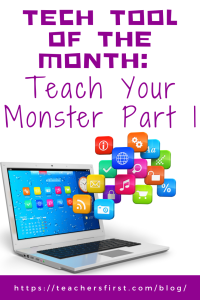Teach Your Monster is a gamified learning journey that captivates young minds. This award-winning educational platform invites students in grades K–2 to create their very own friendly monster character, who then embarks on magical quests through vibrant worlds where literacy, math, and nutrition skills become treasures to discover. Teach Your Monster is home to four games:
- Teach Your Monster to Read, which includes basics of learning letters, sounds, and reading simple phrases;
- Teach Your Monster Reading for Fun, which includes more than 70 fantastic free ebooks, lessons on empathy, and activities to boost reading confidence;
- Teach Your Monster Number Skills, which is packed full of quick games (including manipulatives!) to practice basic arithmetic; and
- Teach Your Monster Adventurous Eating, which the site describes as “a ground-breaking game that encourages kids to eat a broader range of fruit and vegetables and build a better relationship with food.”
As children guide their personalized monsters through engaging games and activities, they master the essentials of phonics, letter and number recognition, healthy eating habits, and reading comprehension—all while having so much fun they barely notice they’re learning. Created by the Usborne Foundation, this cleverly designed digital tool can infuse gamification into math, language arts, and science lessons. Don’t miss the Teachers’ Area, which includes learning resources, one-minute how-to videos, teacher tutorials, information on what each game covers, help articles, and more.
These games are available for free on the web and as apps through Apple’s App Store, Google Play, and Amazon Appstore. Most of the apps are free, but this blog post focuses on the free web version.
Applying the Triple E Framework
The Triple E Framework, created by Dr. Liz Kolb, states that “effective technology integration begins with good instructional strategies and not fancy tools” (tripleeframework.com). Dr. Kolb wrote a book, Learning First, Technology Second (ISTE, 2017), which lays out the three main uses of technology in education: to Engage, Enhance, or Extend learning goals. We can use this framework to decipher why we use specific classroom tools. Here is a rubric based on the Triple E Framework that you can use to evaluate whether Teach Your Monster (or any other technology) is a good fit with your learning goals and whether you should use it in your lesson.
- Engage in learning goals: Teach Your Monster motivates students to begin learning by offering gamified learning with rewards, sound effects, and engaging graphics. The lack of advertisements or other distractions helps students focus on the game’s content.
- Enhance learning goals: Teach Your Monster creates paths for students to demonstrate their understanding of the learning goals in ways that would be impossible without technology. For example, students play games personalized to their level that provide scaffolding: as students navigate through the questions, the program redirects as needed, reads the words out loud, and repeats content until students master it.
- Extend learning goals: Dr. Kolb describes extended learning as an opportunity for students to learn, connect, and collaborate outside the regular school day and as a way to create a bridge between school learning and everyday life experiences. This tool would work well as an at-home activity on virtual learning days, as the teacher can see student progress on their account. The activities on Teach Your Monster would also make an ideal asynchronous learning experience, as students can practice skills on their own and at their own level.
SAMR Connection
The SAMR Model by Dr. Ruben Puentedura suggests that technology implementation has four levels. Therefore, we can use this model as a guideline to analyze how technology can cause an instructional shift in our lessons. For example, we could use Teach Your Monster at the substitution, augmentation, modification, and redefinition levels of SAMR.
- Substitution: The substitution level is the most basic level of SAMR and refers to when technology acts as a direct substitute without any functional improvements. Teach Your Monster can serve as a substitute for traditional books, flashcards, or other letter/word recognition exercises. Students practice the same fundamental skills on a screen rather than with physical materials.
- Augmentation: At the level of augmentation, technology acts as a direct substitute for another activity but also includes some functional improvements. Teach Your Monster provides immediate feedback, adaptive progression with scaffolding, and the ability for teachers to track student progress and monitor achievement to identify all students’ areas of need immediately.
- Modification: The level of modification occurs when technology allows for significant task redesign. Children create their own monsters, make choices that give them ownership of their learning journey, and participate in personalized gamification. The game narrative, audio options, and rewards transform what could be considered repetitive practice into engaging quests for young students.
- Redefinition: The highest level of SAMR, redefinition, occurs when technology allows for the creation of new tasks that were previously inconceivable. Teach Your Monster redefines early literacy instruction by creating fully gamified and immersive learning environments that were not possible without technology. The combination of adaptive learning paths, gamification, interactive storytelling (with audio features), and character development creates an entirely new approach to language arts, math, and nutrition that could not exist without technology.
Take advantage of Part 2 of the Tech Tool of the Month: Teach Your Monster, where we’ll discuss using the tool and ideas for integrating it into your classroom. In the meantime, let us know how you’ve used Teach Your Monster in your education setting in the comment section below.


